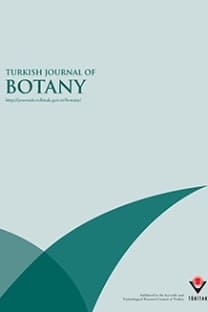Karyomorphological Study of Eight Centaurea L. Taxa (Asteraceae) from Turkey
Image analysis system, Centaurea, Compositae, karyotype, Turkey
Karyomorphological Study of Eight Centaurea L. Taxa (Asteraceae) from Turkey
Image analysis system, Centaurea, Compositae, karyotype, Turkey,
___
- Davis PH, Mill RR & Tan K (1988). Centaurea L. In: Davis PH, Mill RR & Tan K eds. Flora of Turkey and the East Aegean Islands Vol. 10: 166-169 (Supplement). Edinburgh: Edinburgh University Press.
- Dekui Y (2001). The karyotypes studies of Centaurea cyanus and Coreopsis grandiflora. Journal-Shandong Normal University Natural Science 16: 75-78.
- Duran A & Duman H (2002). Two new species of Centaurea (Asteraceae) from Turkey. Ann Bot Fennici 39: 43-48.
- Font M, Garnatje T, Garcia-Jacas N & Susanna A (2002). Delineation and phylogeny of Centaurea sect. Acrocentron based on DNA sequences: a restoration of the genus Crocodylium and indirect evidence of introgression. Plant Syst Evol 234: 15-26.
- Garcia-Jacas N, Susanna A & İlarslan R (1996). Aneuploidy in the Centaureinae (Compositae): Is n = 7 the end of the Series? Taxon 45: 39-42.
- Garcia-Jacas N, Susanna A & İlarslan R (1997). New chromosome counts in the subtribe Centaureinae (Asteraceae, Cardueae) from west Asia. Bot J Linean Soc 125: 343-349.
- Garcia-Jacas N, Susanna A, Vilatersana R & Guara M (1998a). New chromosome counts in the subtribe Centaureinae (Asteraceae, Cardueae) from West Asia, II. Bot J Linn Soc 128: 403-412.
- Garcia-Jacas N, Susanna A & Mozaffarian V (1998b). New chromosome counts in the subtribe Centaureinae (Asteraceae, Cardueae) from West Asia, III. Bot J Linean Soc 128: 413-422.
- Garcia-Jacas N (1998).Centaurea kunkelii (Asteraceae, Cardueae), a new hybridogenic endecaploid species of sect. Acrocentron from Spain Ann Bot Fennici 35: 159-167.
- Garcia-Jacas N, Susanna A, Mozaffarian V & İlarslan R (2000). The
- natural delimitation of Centaurea (Asteraceae: Cardeueae) ITS
- sequence analysis of the Centaurea jacea group. Plant Syst Evol 223: 185-199.
- Garcia-Jacas N, Uysal T, Romashchenko K, Suárez-Santiago VN, Ertuğrul K & Susanna A (2006). Centaurea Revisited: A Molecular Survey of the Jacea Group. Ann Bot 98: 741-753.
- Georgiadis T & Christodoulakis D (1984). Contribution á l’étude cytogéographique des Centaurées de I’ le de Samos. Candollea 39: 307-318.
- Ghaffari SM & Chariat-Panahi S (1985). Chromosome Number Reports LXXXVIII. Taxon 34: 549.
- Gömürgen AN & Adıgüzel N (2001). Chromosome numbers and karyotype analysis of Centaurea tchihatcheffii Fischer & Meyer (Compositae, Cardueae). Ot Sistematik Botanik Dergisi 8: 83-86.
- Güner A (2000). Centaurea L. In: Güner A, Özhatay N, Ekim T & Başer KHC, eds. Flora of Turkey and the East Aegean Islands, Vol. 11: 163-164 (Supplement). Edinburgh: Edinburgh University Press.
- Hellwig HF (1994). Choromosomenzahlen aus der Tribus Cardueae (Compositae). Willdenowia 24: 219-248.
- Karamenderes C, Khan S, Tekwani BL, Jacob MR & Khan IA (2006). Antiprotozoal and antimicrobial activities of Centaurea species growing in Turkey. Pharm Biol 44: 534-539.
- Levan A, Fredga K & Sandberg AA (1964). Nomenclature for centromeric position on chromosomes. Hereditas 52: 201-220.
- Lopez GB (1981). Notes Cariosistemàticas en el género Centaurea L. Sect. Willkommia G.Blanca, II. Conclusions. An Jard Bot 38: 109- 125.
- Martin E, Dinç M, Duran A & Öztürk M (2006). Karyological Studies on Lotus strictus Fisher and C.A.Mey. (Leguminosae), Centaurea amanicola Hub.-Mor. (Compositae) and Teucrium lamiifolium D’urv. subsp. lamiifolium (Labiatae). Am-Euras. J Sci Res 1: 12- 17.
- Morales F (1974). Estudios citogenéticos en espaolas del género Centaurea Granada. Plants Syst Evol 263: 203-207.
- Paszko B (2006). A critical review and a new proposal of karyotype asymmetry indices. Plants Syst Evol 258: 39-48.
- Reyhan A, Küpeli E & Ergun F (2004). The biological activity of Centaurea L. species. G.Ü. Fen Bilimleri Dergisi 17: 149-164.
- Romaschenko K, Ertuğrul K, Susanna A, Garcia-Jacas N, Uysal T & Arslan E (2004). New chromosome counts in the Centaurea Jacea group (Asteraceae, Cardueae) and some related taxa. Bot J Linnean Soc 145: 345-352.
- Strid A (1987). Chromosome numbers of Turkish mountain plants. An annotated list of 34 taxa. Taxon 34: 547-551.
- Tan K & Vural M (2007). Centaurea tchihatcheffii Fischer & C.A.Mey. (Asteraceae)Plants Syst Evol 263: 203-207.
- Türkoğlu I, Akan H & Civelek Ş (2003). A new species ofCentaurea (Asteraceae: sect. Psephelloideae) from Trukey. Bot J Linn Soc 143: 207-212.
- Uzunhisarcıklı ME, Tekşen M & Doğan E (2005). Centaurea marashica (Sect. Pseudoseridia–Asteraceae) a new species from Turkey, Ann Bot Fennici 42: 309-312.
- Villodre JM & Garcia-Jacas N (2000). Pollen studies in subtribe Centaureinae (Asteraceae): the Jacea group analysed with electron microscopy. Bot J Linn Soc 133: 473-484.
- Vural M, Duman H, Aytaç Z & Adıgüzel N (2006). Saponaria karapinarensis, Senecio salsuginea and Centaurea tuzgoluensis, three new species from Central Anatolia, Turkey. Belg J Bot 139: 1-9.
- Wagenitz G, Ertuğrul K & Dural H (1998). A new species of Centaurea sect. Psephelloideae (Compositae) from SW Turkey. Willdenowia 28: 157-161.
- Wagenitz G (1975). Centaurea L. In: Davis PH, ed. Flora of Turkey and the East Aegean Islands. Vol. 5: 465-585, Edinburgh: Edinburgh University Press.
- Wagenitz G (1986). Centaurea in South-West Asia: Patterns of distribution and diversity, Proc. Royal Soc. Edinburgh 89: 11-21.
- ISSN: 1300-008X
- Yayın Aralığı: 6
- Yayıncı: TÜBİTAK
Pollen and Seed Morphology of the Genus Hesperis L. (Brassicaceae) in Turkey
Nur Münevver PINAR, Ahmet DURAN, Talip ÇETER, G. Nilhan TUĞ
Macrofungi of Göksun (Kahramanmaraş) District
Abdullah KAYA, Yusuf UZUN, İbrahim Halil KARACAN
Karyomorphological Study of Eight Centaurea L. Taxa (Asteraceae) from Turkey
Esra MARTİN, Muhittin DİNÇ, Ahmet DURAN
Developmental Stages of Ovule and Megagametophyte in Chenopodium botrys L. (Chenopodiaceae)
Abdolkarim CHEHREGANI, Behrouz MALAYERI, Nafiseh YOUSEFI
Lichens and Lichenicolous Fungi of Kızıldağ (Derebucak, Konya)
Mustafa KOCAKAYA, Mehmet Gökhan HALICI, Ahmet AKSOY
An Alien Species New to the Flora of Turkey:Lysimachia japonica Thunb. (Primulaceae)
Salih TERZİOĞLU, Fergan KARAER
Developmental stages of ovula and megagametophyte in Chenopodium botrys L. (Chenopodiaceae)
Behrouz MALAYERI, Nafiseh YOUSEFI, Abdolkarim CHEHREGANI
The Rediscovery of Some Taxa Thought to Have Been Extinct in Turkey
